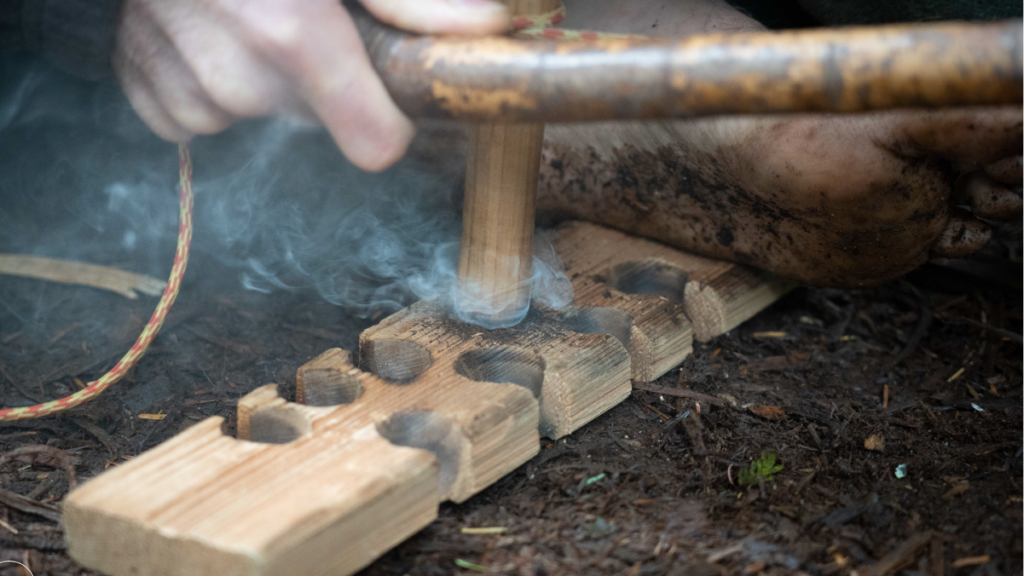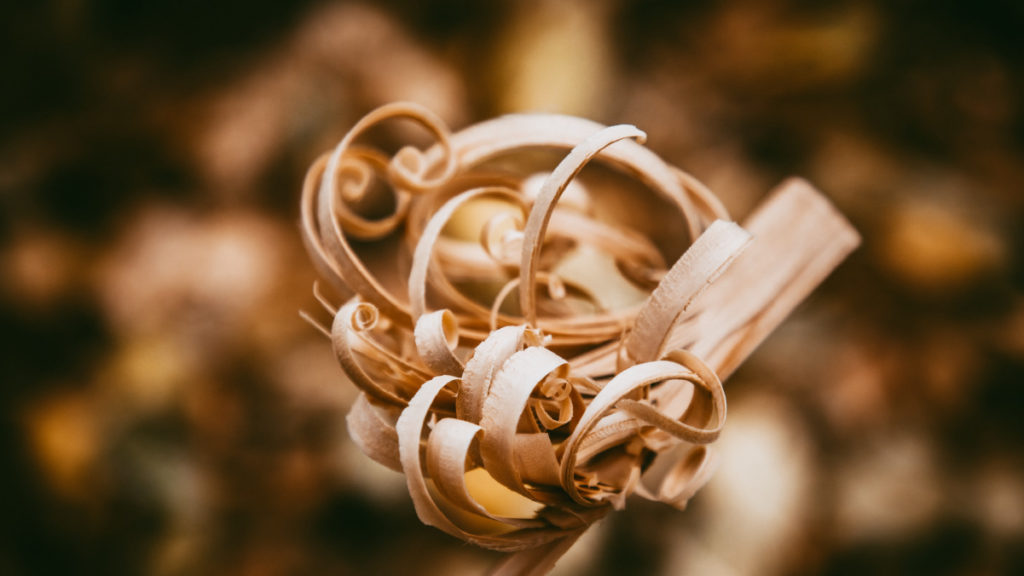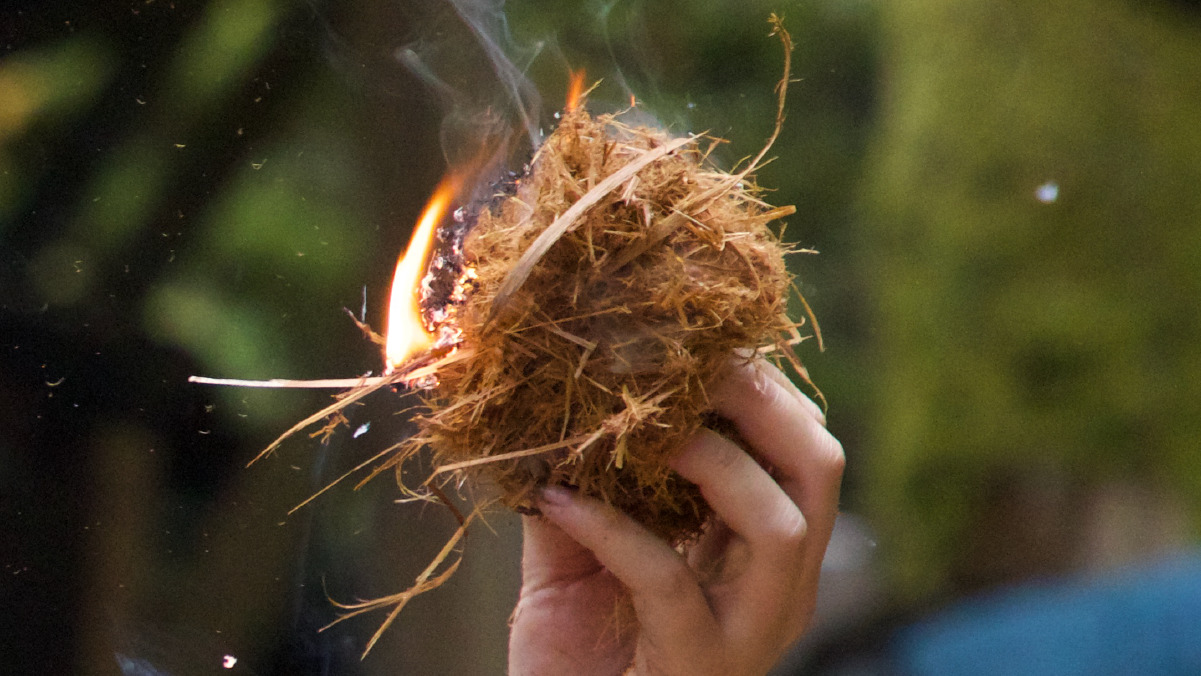Before we introduced ourselves at Wilderness Awareness School’s Wild Women’s Weekend last October, the weekend’s host passed the hypothetical torch over to Marina Rivera who would make the first ceremonial fire to begin the weekend.
Wordlessly, Marina stepped in slow, dancer-like steps towards a piece of wood that she held with one bare foot. She took several large steady breaths, closed her eyes, and when she opened them, she began. With one hand, she held a wood spindle to drill into the board on the ground. Then she took a handmaid bow and she sawed, moving the spindle back and forth, causing friction between the spindle and the board on the ground. Every once in a while, she’d take some intentional breaths. And before long, there were small wisps of smoke rising from the hole the spindle had drilled. A coal. She took a soft tuft of cedar tree bark and placed the coal within.

Marina knelt and blew gentle, calm breaths into the tuft of bark. When soft flames rose up from the bark, she transferred the fire to a beautiful piece of wood that she had carved thin ribbons of wood that coalesced at the end of the main stick. The fire was transferred to this feather stick, which was then transferred to a small pile of tinder in the fire pit. And, voila, there was fire…for a brief moment before Marina inevitably had to put it out because there was a fire ban.
Throughout this entire ceremony, I could not take my eyes off Marina. There were few sounds other than her breathing and then the eventual crackle of a fire, and every one of the 50 or so attendees watched, rapt with attention. I had no idea what the tools she used were called. But I could tell something more than just fire making was happening. It was, well, kind of spiritual.
Even as I write that, I feel a little cringe-y casting some spiritual element to this. It feels a bit too “on the nose” with this kind of back-to-the-land kind of journey I’m on. But I did feel something watching Marina that was beyond the realization that I could actually learn these skills to stay alive in the *apocalypse.
As I watched Marina make fire from what seemed like nothing, as I watched her take steady breaths, as I watched her seemingly tune out the 100+ eyes on her, it occurred to me that a skill like fire-making wasn’t just a hard skill, there was something softer in there, something rooted in intuition.
This was all but confirmed when we had broken off into smaller groups for workshops. To my delight, Marina’s fire-making workshop was my introduction to the weekend’s activities. And as she began and introduced us to all the tools she was using or can be used in primitive friction firemaking (a bow drill, cedar bark, feather sticks, and kindling), my excitement rose as I realized that by the end of that session, I might finally learn how to make a fire from the materials already around me.
And then, Marina hit us with a piece of knowledge that stopped me, metaphorically speaking, in my tracks.
“I can carry all the tools to make a fire: nature’s blowtorch,” she said. “While those are great, they’re a direct compensation for our lack of knowledge about our environment.”
“Holy shit,” I thought. I thought back to the last couple of camping trips where I had attempted to make primitive fire with just a Ferro rod and some kindling (and I didn’t even know the proper name of the Ferro rod that first attempt). I eventually had to light the fire with a lighter. I was frustrated at myself but also desperate because we had small children to feed, so I was going to make fire with whatever I had around me.
“As I get to know the land, I don’t need to carry those things,” she continued. “But that’s not what this class is about.”
Ha, of course it’s not. Of course I’m not going to learn the ins and outs of the land in order to make fire anyhow anywhere I want in 2-3 convenient hours. Nonetheless, I was totally in. I was ready to start that journey.

After the requisite rule-setting (we were working with sharp objects, after all), Marina demonstrated all the skills we would be learning from wood-chopping, fuel gathering, feather stick-making, and then fire lighting with a ferro rod and knife. As she demonstrated each of these skills, I realized a couple of things. First, a whole lot of work goes into the preparation of all of the materials before you even try to get that fire going. And second, Marina often used the term “get fire” versus “make fire.”
I asked about this, and after she thought for a moment, she said this:
“[Getting fire] requires skill, but also emotional attunement. I think that as human beings, fire is ingrained in our bodies. Not just a center for community but who we are. I see metaphors for fire everywhere.”
Getting fire then implies that fire is already there, it’s just a matter of being open to it. I then recalled the graceful dance Marina did to get that first fire of the day in the middle of a circle of eager, excited women. I wondered if the pressure of that moment required an attunement to the task and the body to ensure you were able to get that fire.
And with this realization, this a-ha moment about “getting fire,” a quest I had been on from the very beginning of my apocalypse prepping journey, it occurred to me that the “hard” and “soft” skills a part of this journey aren’t all that different. They exist on a spectrum, if you will. And what I mean by “hard skills” are those quantifiable sets of objective skills that you build through time and hard work. By “soft skills,” I’m talking about those qualitative, subjective skills that are hard to measure like critical thinking and listening. Fire making–or fire getting–is the perfect example. While there are certain things you need to know to make a primitive fire–to gather the right kind and amount of bark, the specific way you use a Ferro rod or bow drill in order to create a spark, how you chop your wood to get the right size of kindling. But when you get to the point of actually making the fire, there is no guarantee that fire will happen, even if you know how to do all of the things that, in theory, would get you fire.
Getting fire requires presence and intuition. It also requires patience.
I am pleased to report that by the end of this workshop I did get fire. I chopped wood like a badass, I made some crude not-so-beautiful-but-still-workable feather sticks, I collected a beautiful tuft of cedar by scraping the inside of a cedar bark plank with a hatchet, and I created a coal with the Ferro rod that caught a small piece of charcoal made from dehydrated denim. Once inserted into the tuft of cedar, that spark continued to catch fire thanks to my gentle breaths, which I then transferred to that crude feather stick and placed in the fire pit. I made a fire.
But then in our final task to make fire with just one match within a matter of five minutes, the pressure caught up to me. I did not succeed at that task. My heart was pumping, and I was frustrated with myself in the end wondering if I did have what it took to make fire.
Then I remembered something Marina had said earlier: “If the fire doesn’t come, you need to do something different.”
What was different was the pressure. I’m not exactly sure if Marina intended that to be the lesson because a whole lot of the other attendees succeeded in this one-match-fire task set out to them. But my failure actually helped. And also the review of my notes and Marina’s quotes afterwards.
“I personally believe it’s better to be calm and not have fire than panicking and having a fire,” she had said earlier. “Try to invite the fire on versus trying to make the fire.”
I had not invited that fire to come. It didn’t matter how much time I spent on all of the materials or all of the skills I had, in theory, applied as I was instructed. I was not in the right mental space to receive the fire.
There is, I realized, spirituality that is a part of this whole skill-building process. There are soft skills and a sense of awareness that are a part of every hard skill I’m working towards. The entire weekend organized by Wilderness Awareness School seemed to have been organized around this spectrum of soft and hard skills. Half the sessions leaned softer (the mindfulness and nature play sessions), and the others (fire and plant sessions) leaned harder. But they all required an awareness of nature and ourselves that were very much on the “softer” end of the spectrum.
For that reason, I knew I was in the right place. I had never really been drawn to the hyper-masculine, hard-skill focused aspect of the traditional prepper community, but I wasn’t quite aware what the alternative was. There was a sense of grace within the Wilderness Awareness School approach to skill-building. This acknowledges that there’s spectrum on which we all exist and that we’re going to be drawn to one skill more deeply than another and that there is no real mastery of one skill or another. This isn’t a race, it is a matter of intuition that we are honing. And that intuition (with a bit of knowing the basics) could be that key to survival in the apocalypse.
*Elizabeth Doerr is a published author and writer for her blog and future book, Cramming for the Apocalypse. She attended the fall session of Wild Women’s Weekend in 2022 as part of her research and personal journey.
